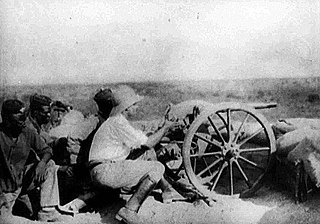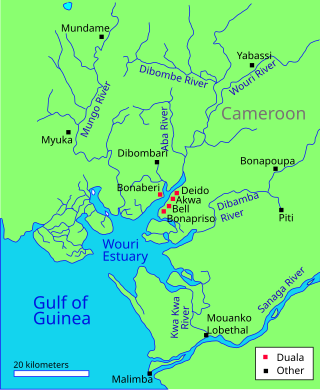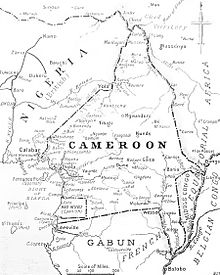
Kamerun was an African colony of the German Empire from 1884 to 1920 in the region of today's Republic of Cameroon. Kamerun also included northern parts of Gabon and the Congo with western parts of the Central African Republic, southwestern parts of Chad and far northeastern parts of Nigeria.

The African theatre of the First World War comprises campaigns in North Africa instigated by the German and Ottoman empires, local rebellions against European colonial rule and Allied campaigns against the German colonies of Kamerun, Togoland, German South West Africa, and German East Africa. The campaigns were fought by German Schutztruppe, local resistance movements and forces of the British Empire, France, Italy, Belgium, and Portugal.
The Pallottine Mission to Kamerun was a Roman Catholic mission to the German colony of Kamerun run by the Pallottines in the late 19th and early 20th centuries. When the German Empire became the colonial power of Kamerun in 1884, French Catholic groups were denied permission to set up a mission in the territory. The Germans were not eager to allow Catholics in at all, let alone foreign ones. They relented two years later when the German and Swiss-run Pallottines requested entry. Permission came with the following conditions: The Pallottines were not to compete directly with the already established Protestant Basel Mission, they were to accept no orders from any non-German authority, they were to employ only German or African staff, and they were to use and teach only the German language.
Mora is a town in northern Cameroon. Mora has a population of 55,216 making it the 5th biggest city in Far North.

The Togoland campaign was a French and British invasion of the German colony of Togoland in West Africa, which began the West African campaign of the First World War. German colonial forces withdrew from the capital Lomé and the coastal province to fight delaying actions on the route north to Kamina, where the Kamina Funkstation linked the government in Berlin to Togoland, the Atlantic and South America.
The Battle of Tepe on 25 August 1914 was the first skirmish between German and British forces during the Kamerun campaign in of the First World War. The conflict took place on the border between British Nigeria and German Kamerun, ending in British victory and German withdrawal from the station.

The First Battle of Garua took place from 29 to 31 August 1914 during the Kamerun campaign of the First World War between German and invading British forces in northern Kamerun at Garua. It was the first significant action to take place in the campaign and resulted in the German repulsion of the British force.
The Battle of Nsanakong or Battle of Nsanakang took place between defending British and attacking German forces during the Kamerun campaign of the First World War. The town of Nsanakong had been occupied by the British on 30 August 1914. On 6 September, German forces attacked, driving the British force over the border back into Nigeria.

The Naval operations of the Kamerun campaign were carried out by German and Allied forces during the Kamerun campaign of the First World War from August to September 1914. Naval activity occurred all along the coast of German Kamerun in the Bight of Bonny but most of the action took place in the Wouri estuary. The main event of the campaign were the successful British and French amphibious landings at Duala. The operations carried out by British and French naval forces concluded in securing control over the German colony's entire coastline and the destruction of any German naval vessels that were capable of offering resistance. Allied occupation of the coastline forced the Germans to retreat into the interior of Kamerun where they would meet their defeat in 1916.
The siege of Mora or siege of Moraberg, between Allied and besieged German troops, took place from August 1914 to February 1916 on and around the Mora mountain in northern Kamerun during the Kamerun campaign of the First World War. After more than a year of siege German forces on the mountain surrendered, following the escape of many German troops to the neutral Spanish colony of Río Muni. It was the second longest siege of the war, behind the Siege of Medina.
The Battle of Ukoko took place on 21 September 1914 during the Kamerun campaign of the First World War between French and German troops in Ukoko, Kamerun or modern day Cocobeach, Gabon.
The Battle of Gurin took place on 29 April 1915 during the Kamerun campaign of World War I in Gurin, British Nigeria near the border with German Kamerun. The battle was one of the largest of the German forays into the British colony. It ended in a successful British repulsion of the German force.

The Second Battle of Garua took place from 31 May to 10 June 1915 during the Kamerun campaign of the First World War in Garua, German Kamerun. The battle was between a combined French and British force and defending German garrison and resulted in an Allied victory.
The Battle of Ngaundere or Battle of Ngaoundéré was a small engagement fought between German and British forces on 29 June 1915 during the Kamerun campaign of World War I. It resulted in a German defeat and British occupation of the town.
During the Battle of Banjo or Battle of Banyo, British forces besieged German forces entrenched on the Banjo mountain from 4 to 6 November 1915 during the Kamerun campaign of the First World War. By 6 November much of the German force had deserted, while the rest surrendered. The battle resulted in victory for the Allies and breakdown of German resistance in northern Kamerun.
The Second Battle of Edea was the German counter-attack against French forces stationed in the village of Edea during the Kamerun campaign of the First World War. Allied forces from Duala occupied the town following the First Battle of Edea in October 1914. The Germans, eager to retake the position attacked on 5 January 1915 but were repulsed by the French force.
The Second Battle of Jaunde involved the successful British and French assault on the German capital of Jaunde during the Kamerun campaign of the First World War. After the failure of the First Battle of Jaunde during the summer of 1915, the bulk of Allied forces had retreated to the Kele river. Following the Second Duala Conference where Allied commanders discussed the situation, it was decided that another assault should be attempted. Although the columns surrounding Jaunde were not in effective communication with one another, on 1 January 1916, British forces under Colonel Georges occupied the capital. By this time it had been abandoned by the German troops who had fled to the neutral Spanish colony of Río Muni. This Allied victory signaled the end of German resistance in Kamerun apart from the Siege of Mora which would continue for another few months.
The First Battle of Edea involved the British and French assault on German forces stationed in the village of Edea during the Kamerun campaign of the First World War. Allied forces from Duala launched their advance on 20 October. Following stiff resistance along the southern railway line between Duala and Edea, German forces withdrew from the town to Jaunde, allowing Allied troops to finally occupy Edea on 26 October 1914.

Frederick Hugh Gordon Cunliffe, (1861-1955) was a British Brigadier who was one of the main British commanders at the Kamerun campaign and earned a key victory at the Siege of Mora.

Ernst Klaus Iwan Christian Friedrich Alfred von Raben was a German Major who had served as a commander of the Schutztruppe before surrendering at the Siege of Mora.








